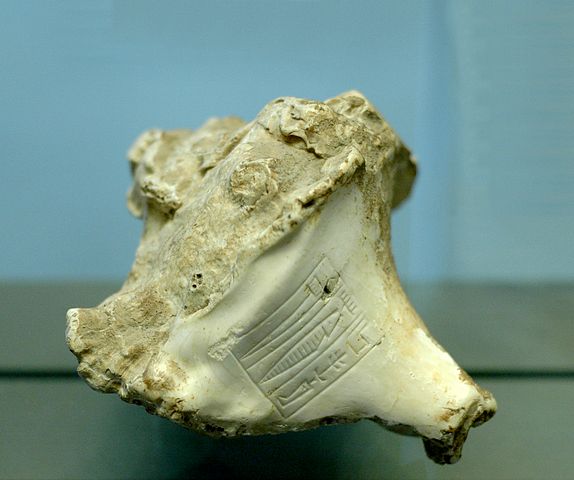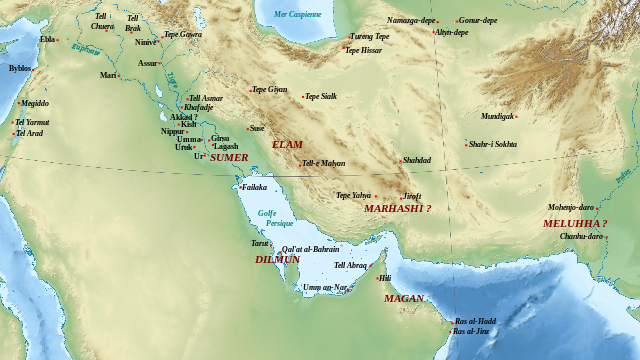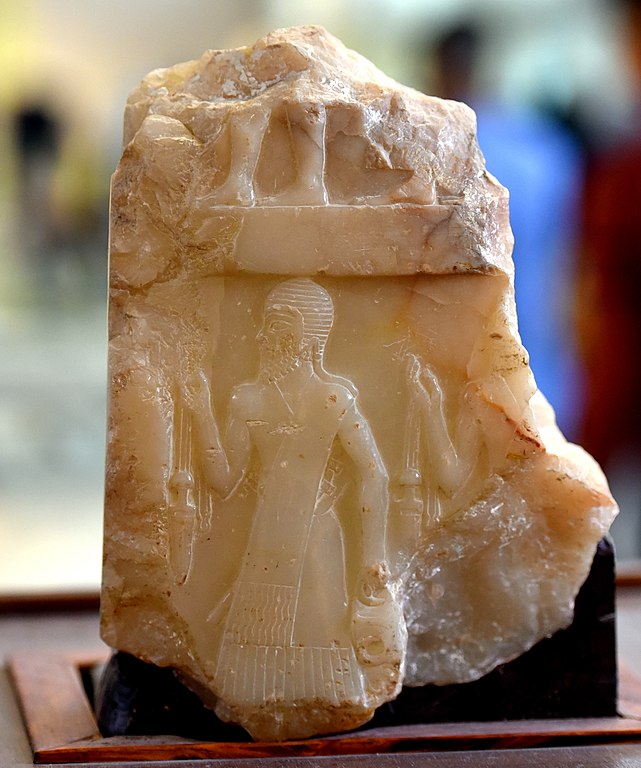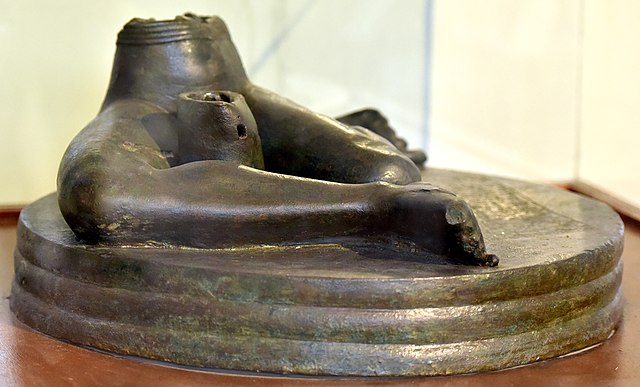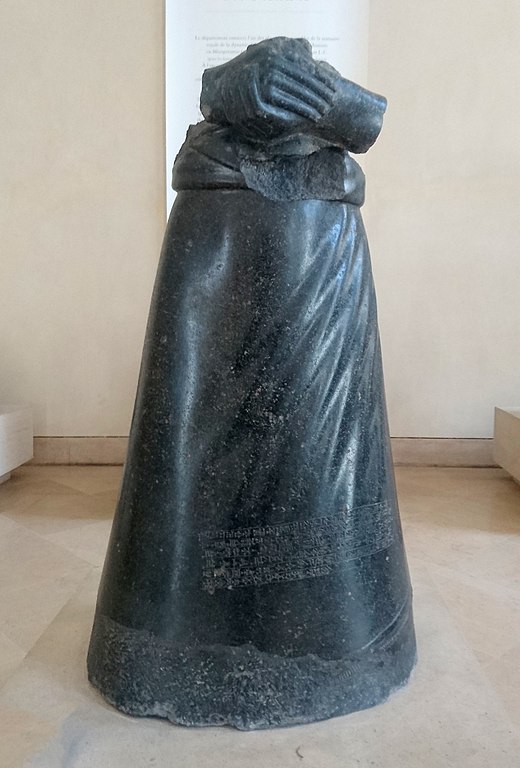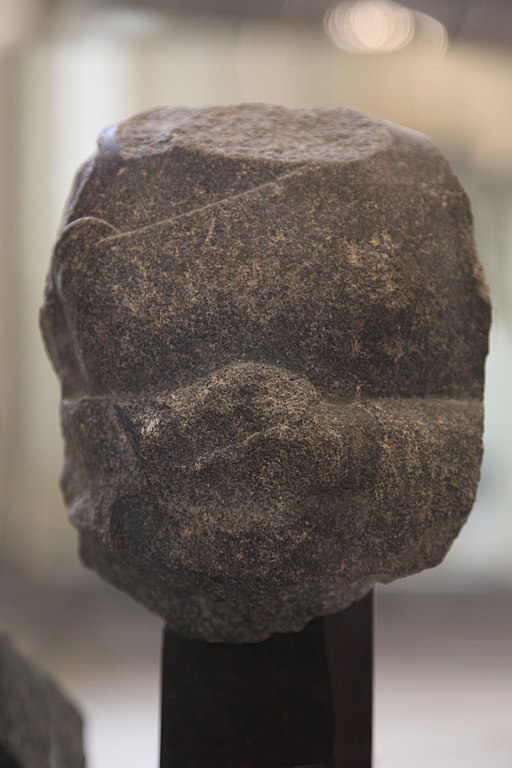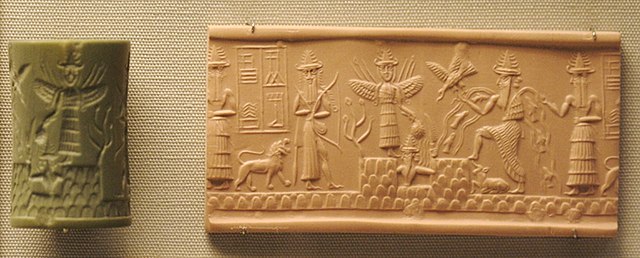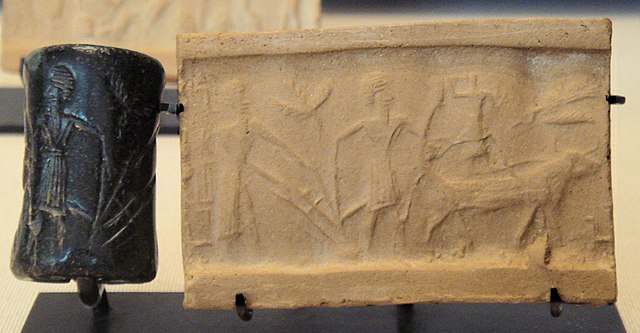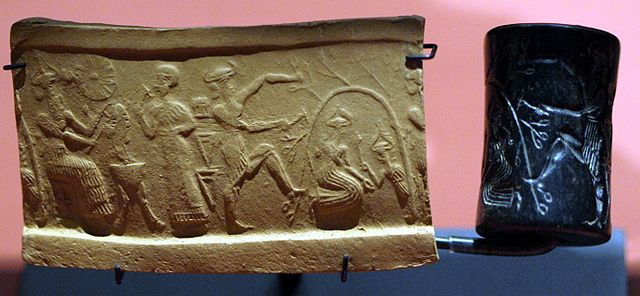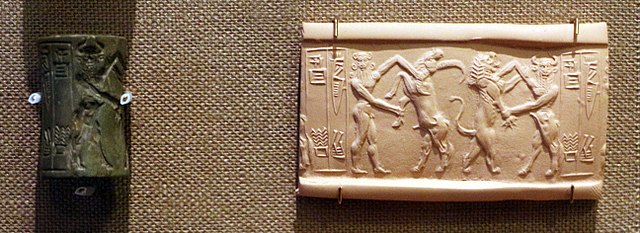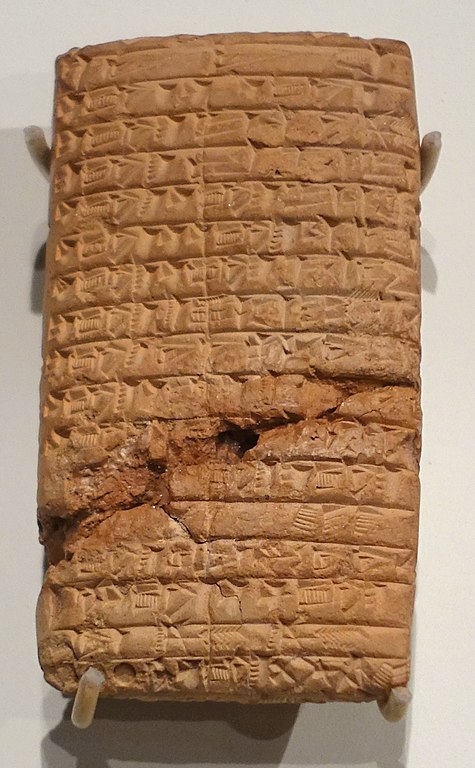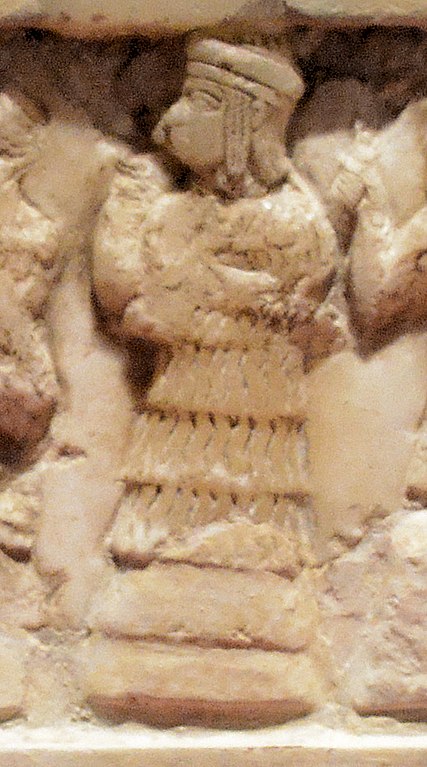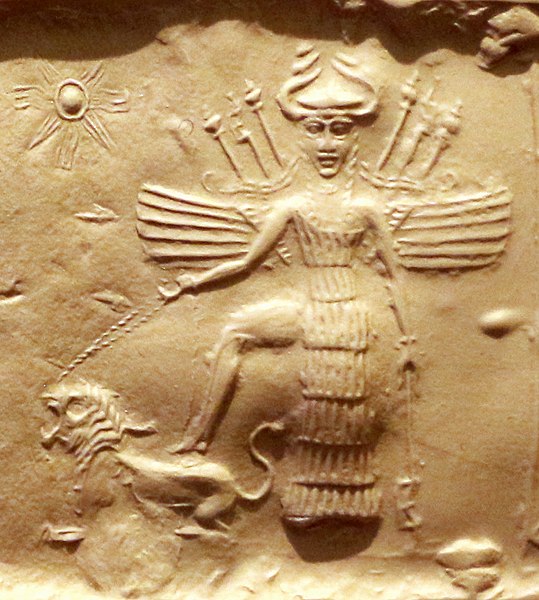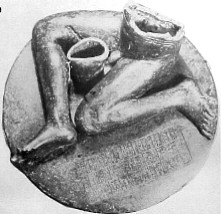
| AKKADIAN EMPIRE
Bronze head of an Akkadian ruler, discovered in Nineveh in 1931, presumably depicting either Sargon or, more probably, Sargon's grandson Naram-Sin. Reproduction in the Roemer- und Pelizaeus-Museum Hildesheim, the original from the National Museum of Iraq having been lost in the 2003 lootings.
Map of the Akkadian Empire (brown) and the directions in which military campaigns were conducted (yellow arrows) Akkadian Empire c. 2334 - 2154 BC
Capital : Akkad
Official languages : Akkadian and Sumerian
Common languages : Akkadian and Sumerian (declining)
Religion : Ancient Mesopotamian religion
Government : Monarchy
Sarrum
• c. 2334 - 2279 BC : Sargon (first)
• c. 2170 - 2154 BC : Shu-turul (last)
Historical era : Bronze Age
• Established : c. 2334 BC
• Conquests of Sargon of Akkad : c. 2340 - 2284 BC
• Disestablished : c. 2154 BC
Area
2350 BC : 30,000 km2 (12,000 sq mi)
2300 BC : 650,000 km2 (250,000 sq mi)
2250 BC : 800,000 km2 (310,000 sq mi)
2200
BC : 250,000 km2 (97,000 sq mi)
Preceded by
Early
Dynastic Period
Succeeded by
Gutian Period (Sumer)
Third Mariote Kingdom
Ebla
Today part of : Iraq, Iran, Syria and Turkey
The Akkadian Empire was the second ancient empire of Mesopotamia, after the long-lived civilization of Sumer. It was centered in the city of Akkad /'ækæd and its surrounding region. The empire united Akkadian (Assyrian and Babylonian) and Sumerian speakers under one rule. The Akkadian Empire exercised influence across Mesopotamia, the Levant, and Anatolia, sending military expeditions as far south as Dilmun and Magan (modern Bahrain and Oman) in the Arabian Peninsula.
During the 3rd millennium BC, there developed a cultural symbiosis between the Sumerians and the Akkadians, which included widespread bilingualism. Akkadian, an East Semitic language, gradually replaced Sumerian as a spoken language somewhere between the 3rd and the 2nd millennia BC (the exact dating being a matter of debate).
The Akkadian Empire reached its political peak between the 24th and 22nd centuries BC, following the conquests by its founder Sargon of Akkad. Under Sargon and his successors, the Akkadian language was briefly imposed on neighboring conquered states such as Elam and Gutium. Akkad is sometimes regarded as the first empire in history, though the meaning of this term is not precise, and there are earlier Sumerian claimants.
After the fall of the Akkadian Empire, the people of Mesopotamia eventually coalesced into two major Akkadian-speaking nations: Assyria in the north, and, a few centuries later, Babylonia in the south.
History
of research :
"The
beginning of his [Nimrod's] kingdom was Babel, and Erech, and Accad,
and Calneh, in the land of Shinar. Out of that land he went forth
into Assyria, and builded Nineveh, and Rehoboth-Ir, and Calah, and
Resen between Nineveh and Calah (the same is the great city)."
Understanding of the Akkadian Empire continues to be hampered by the fact that its capital Akkad has not yet been located, despite numerous attempts. Precise dating of archaeological sites is hindered by the fact that there are no clear distinctions between artifact assemblages thought to stem from the preceding Early Dynastic period, and those thought to be Akkadian. Likewise, material that is thought to be Akkadian continues to be in use into the Ur III period.
Many of the more recent insights on the Akkadian Empire have come from excavations in the Upper Khabur area in modern northeastern Syria which was to become a part of Assyria after the fall of Akkad. For example, excavations at Tell Mozan (ancient Urkesh) brought to light a sealing of Tar'am-Agade, a previously unknown daughter of Naram-Sin, who was possibly married to an unidentified local endan (ruler). The excavators at nearby Tell Leilan (ancient Shekhna/Shubat-Enlil) have used the results from their investigations to argue that the Akkadian Empire came to an end due to a sudden drought, the so-called 4.2 kiloyear event. The impact of this climate event on Mesopotamia in general, and on the Akkadian Empire in particular, continues to be hotly debated.
Excavation at the modern site of Tell Brak has suggested that the Akkadians rebuilt a city ("Brak" or "Nagar") on this site, for use as an administrative center. The city included two large buildings including a complex with temple, offices, courtyard, and large ovens.
Dating
and periodization :
Timeline
of rulers :
Family Tree History
and development of the empire :
Akkad before expansion (in green). The territory of Sumer under its last king Lugal-Zage-Si appears in orange. Circa 2350 BC
Sargon on his victory stele, with a royal hair bun, holding a mace and wearing a flounced royal coat on his left shoulder with a large belt (left), followed by an attendant holding a royal umbrella. The name of Sargon in cuneiform ("King Sargon") appears faintly in front of his face. Louvre Museum.
Akkadian official in the retinue of Sargon of Akkad, holding an axe The Akkadian Empire takes its name from the region and the city of Akkad, both of which were localized in the general confluence area of the Tigris and Euphrates Rivers. Although the city of Akkad has not yet been identified on the ground, it is known from various textual sources. Among these is at least one text predating the reign of Sargon. Together with the fact that the name Akkad is of non-Akkadian origin, this suggests that the city of Akkad may have already been occupied in pre-Sargonic times.
Sargon
of Akkad :
My mother was a changeling, my father I knew not. The brothers of my father loved the hills. My city is Azurpiranu (the wilderness herb fields), which is situated on the banks of the Euphrates. My changeling mother conceived me, in secret she bore me. She set me in a basket of rushes, with bitumen she sealed my lid. She cast me into the river which rose not over me. The river bore me up and carried me to Akki, the drawer of water. Akki, the drawer of water, took me as his son and reared me. Akki the drawer of water, appointed me as his gardener. While I was gardener Ishtar granted me her love, and for four and (fifty?) ... years I exercised kingship.
Later claims made on behalf of Sargon were that his mother was an "entu" priestess (high priestess). The claims might have been made to ensure a pedigree of nobility, since only a highly placed family could achieve such a position.
Originally a cupbearer (Rabshakeh) to a king of Kish with a Semitic name, Ur-Zababa, Sargon thus became a gardener, responsible for the task of clearing out irrigation canals. The royal cupbearer at this time was in fact a prominent political position, close to the king and with various high level responsibilities not suggested by the title of the position itself. This gave him access to a disciplined corps of workers, who also may have served as his first soldiers. Displacing Ur-Zababa, Sargon was crowned king, and he entered upon a career of foreign conquest. Four times he invaded Syria and Canaan, and he spent three years thoroughly subduing the countries of "the west" to unite them with Mesopotamia "into a single empire".
However, Sargon took this process further, conquering many of the surrounding regions to create an empire that reached westward as far as the Mediterranean Sea and perhaps Cyprus (Kaptara); northward as far as the mountains (a later Hittite text asserts he fought the Hattian king Nurdaggal of Burushanda, well into Anatolia); eastward over Elam; and as far south as Magan (Oman) — a region over which he reigned for purportedly 56 years, though only four "year-names" survive. He consolidated his dominion over his territories by replacing the earlier opposing rulers with noble citizens of Akkad, his native city where loyalty would thus be ensured.
Prisoners escorted by a soldier, on a victory stele of Sargon of Akkad, circa 2300 BCE The
hairstyle of the prisoners (curly hair on top and short hair on
the sides) is characteristic of Sumerians, as also seen on the Standard
of Ur. Louvre Museum.
Images of Sargon were erected on the shores of the Mediterranean, in token of his victories, and cities and palaces were built at home with the spoils of the conquered lands. Elam and the northern part of Mesopotamia (Assyria/Subartu) were also subjugated, and rebellions in Sumer were put down. Contract tablets have been found dated in the years of the campaigns against Canaan and against Sarlak, king of Gutium. He also boasted of having subjugated the "four-quarters" — the lands surrounding Akkad to the north (Assyria), the south (Sumer), the east (Elam), and the west (Martu). Some of the earliest historiographic texts (ABC 19, 20) suggest he rebuilt the city of Babylon (Bab-ilu) in its new location near Akkad.
Sargon, throughout his long life, showed special deference to the Sumerian deities, particularly Inanna (Ishtar), his patroness, and Zababa, the warrior god of Kish. He called himself "The anointed priest of Anu" and "the great ensi of Enlil" and his daughter, Enheduanna, was installed as priestess to Nanna at the temple in Ur.
Troubles multiplied toward the end of his reign. A later Babylonian text states :
In his old age, all the lands revolted against him, and they besieged him in Akkad (the city) [but] he went forth to battle and defeated them, he knocked them over and destroyed their vast army.
It refers to his campaign in "Elam", where he defeated a coalition army led by the King of Awan and forced the vanquished to become his vassals.
Also shortly after, another revolt took place :
The Subartu (mountainous tribes of Assyria) the upper country—in their turn attacked, but they submitted to his arms, and Sargon settled their habitations, and he smote them grievously.
Rimush and Manishtushu :
Sargon had crushed opposition even at old age. These difficulties broke out again in the reign of his sons, where revolts broke out during the nine-year reign of Rimush (2278–2270 BC), who fought hard to retain the empire, and was successful until he was assassinated by some of his own courtiers. According to his inscriptions, he faced widespread revolts, and had to reconquer the cities of Ur, Umma, Adab, Lagash, Der, and Kazallu from rebellious ensis: Rimush introduced mass slaughter and large scale destruction of the Sumerian city-states, and maintained meticulous records of his destructions. Most of the major Sumerian cities were destroyed, and Sumerian human losses were enormous :
Rimush's elder brother, Manishtushu (2269–2255 BC) succeeded him. The latter seems to have fought a sea battle against 32 kings who had gathered against him and took control over their pre-Arab country, consisting of modern-day United Arab Emirates and Oman. Despite the success, like his brother he seems to have been assassinated in a palace conspiracy.
Naram-Sin :
Manishtushu's son and successor, Naram-Sin (2254–2218 BC), due to vast military conquests, assumed the imperial title "King Naram-Sin, king of the four-quarters" (Lugal Naram-Sîn, Šar kibrat 'arbaim), the four-quarters as a reference to the entire world. He was also for the first time in Sumerian culture, addressed as "the god (Sumerian = DINGIR, Akkadian = ilu) of Agade" (Akkad), in opposition to the previous religious belief that kings were only representatives of the people towards the gods. He also faced revolts at the start of his reign, but quickly crushed them.
Victory Stele of Naram-Sin, celebrating victory against the Lullubi from Zagros 2260 BC He
is wearing a horned helmet, a symbol of divinity, and is also portrayed
in a larger scale in comparison to others to emphasize his superiority.
Brought back from Sippar to Susa as war prize in the 12th century
BC.
To better police Syria, he built a royal residence at Tell Brak, a crossroads at the heart of the Khabur River basin of the Jezirah. Naram-Sin campaigned against Magan which also revolted; Naram-Sin "marched against Magan and personally caught Mandannu, its king", where he instated garrisons to protect the main roads. The chief threat seemed to be coming from the northern Zagros Mountains, the Lulubis and the Gutians. A campaign against the Lullubi led to the carving of the "Victory Stele of Naram-Suen", now in the Louvre. Hittite sources claim Naram-Sin of Akkad even ventured into Anatolia, battling the Hittite and Hurrian kings Pamba of Hatti, Zipani of Kanesh, and 15 others. This newfound Akkadian wealth may have been based upon benign climatic conditions, huge agricultural surpluses and the confiscation of the wealth of other peoples.
The economy was highly planned. Grain was cleaned, and rations of grain and oil were distributed in standardized vessels made by the city's potters. Taxes were paid in produce and labour on public walls, including city walls, temples, irrigation canals and waterways, producing huge agricultural surpluses.
In later Assyrian and Babylonian texts, the name Akkad, together with Sumer, appears as part of the royal title, as in the Sumerian LUGAL KI-EN-GI KI-URI or Akkadian Šar mat Šumeri u Akkadi, translating to "king of Sumer and Akkad". This title was assumed by the king who seized control of Nippur, the intellectual and religious center of southern Mesopotamia.
During the Akkadian period, the Akkadian language became the lingua franca of the Middle East, and was officially used for administration, although the Sumerian language remained as a spoken and literary language. The spread of Akkadian stretched from Syria to Elam, and even the Elamite language was temporarily written in Mesopotamian cuneiform. Akkadian texts later found their way to far-off places, from Egypt (in the Amarna Period) and Anatolia, to Persia (Behistun).
Submission
of Sumerian kings :
“Naram-Sin, the mighty God of Agade, king of the four corners of the world, Lugal-ushumgal, the scribe, ensi of Lagash, is thy servant.”
—
Seal of Lugal-ushumgal as vassal of Naram-sin.
Collapse :
The Gutians capturing a Babylonian city, as the Akkadians are making a stand outside of their city. 19th century illustration The empire of Akkad fell, perhaps in the 22nd century BC, within 180 years of its founding, ushering in a "Dark Age" with no prominent imperial authority until Third Dynasty of Ur. The region's political structure may have reverted to the status quo ante of local governance by city-states.
Shu-turul appears to have restored some centralized authority; however, he was unable to prevent the empire eventually collapsing outright from the invasion of barbarian peoples from the Zagros Mountains known as the Gutians.
Little is known about the Gutian period, or how long it endured. Cuneiform sources suggest that the Gutians' administration showed little concern for maintaining agriculture, written records, or public safety; they reputedly released all farm animals to roam about Mesopotamia freely and soon brought about famine and rocketing grain prices. The Sumerian king Ur-Nammu (2112–2095 BC) cleared the Gutians from Mesopotamia during his reign.
The Sumerian King List, describing the Akkadian Empire after the death of Shar-kali-shari, states :
Who was king? Who was not king? Irgigi the king; Nanum, the king; Imi the king; Ilulu, the king—the four of them were kings but reigned only three years. Dudu reigned 21 years; Shu-Turul, the son of Dudu, reigned 15 years. ... Agade was defeated and its kingship carried off to Uruk. In Uruk, Ur-ningin reigned 7 years, Ur-gigir, son of Ur-ningin, reigned 6 years; Kuda reigned 6 years; Puzur-ili reigned 5 years, Ur-Utu reigned 6 years. Uruk was smitten with weapons and its kingship carried off by the Gutian hordes.
However, there are no known year-names or other archaeological evidence verifying any of these later kings of Akkad or Uruk, apart from several artefact referencing king Dudu of Akkad and Shu-turul. The named kings of Uruk may have been contemporaries of the last kings of Akkad, but in any event could not have been very prominent.
In the Gutian hordes, (first reigned) a nameless king; (then) Imta reigned 3 years as king; Shulme reigned 6 years; Elulumesh reigned 6 years; Inimbakesh reigned 5 years; Igeshuash reigned 6 years; Iarlagab reigned 15 years; Ibate reigned 3 years; ... reigned 3 years; Kurum reigned 1 year; ... reigned 3 years; ... reigned 2 years; Iararum reigned 2 years; Ibranum reigned 1 year; Hablum reigned 2 years; Puzur-Sin son of Hablum reigned 7 years; Iarlaganda reigned 7 years; ... reigned 7 years; ... reigned 40 days. Total 21 kings reigned 91 years, 40 days.
"Cylinder Seal with King or God and Vanquished Lion" (Old Akkadian). The Walters Art Museum The period between c. 2112 BC and 2004 BC is known as the Ur III period. Documents again began to be written in Sumerian, although Sumerian was becoming a purely literary or liturgical language, much as Latin later would be in Medieval Europe.
One explanation for the end of the Akkadian empire is simply that the Akkadian dynasty could not maintain its political supremacy over other independently powerful city-states.
Drought
:
Peter B. deMenocal has shown "there was an influence of the North Atlantic Oscillation on the streamflow of the Tigris and Euphrates at this time, which led to the collapse of the Akkadian Empire". More recent analysis of simulations from the HadCM3 climate model indicate that there was a shift to a more arid climate on a timescale that is consistent with the collapse of the empire.
Impression
of a cylinder seal of the time of Akkadian King Sharkalisharri (c.2200
BC), with central inscription: "The Divine Sharkalisharri Prince
of Akkad, Ibni-Sharrum the Scribe his servant". The long-horned
buffalo is thought to have come from the Indus Valley, and testifies
to exchanges with Meluhha (the Indus Valley civilization) in a case
of Indus-Mesopotamia relations. Circa 2217–2193 BC. Louvre
Museum.
This collapse of rain-fed agriculture in the Upper Country meant the loss to southern Mesopotamia of the agrarian subsidies which had kept the Akkadian Empire solvent. Water levels within the Tigris and Euphrates fell 1.5 meters beneath the level of 2600 BC, and although they stabilized for a time during the following Ur III period, rivalries between pastoralists and farmers increased. Attempts were undertaken to prevent the former from herding their flocks in agricultural lands, such as the building of a 180 km (112 mi) wall known as the "Repeller of the Amorites" between the Tigris and Euphrates under the Ur III ruler Shu-Sin. Such attempts led to increased political instability; meanwhile, severe depression occurred to re-establish demographic equilibrium with the less favorable climatic conditions.
Richard Zettler has critiqued the drought theory, observing that the chronology of the Akkadian empire is very uncertain and that available evidence is not sufficient to show its economic dependence on the northern areas excavated by Weiss and others. He also criticizes Weiss for taking Akkadian writings literally to describe certain catastrophic events.
According to Joan Oates, at Tell Brak, the soil "signal" associated with the drought lies below the level of Naram-Sin's palace. However, evidence may suggest a tightening of Akkadian control following the Brak 'event', for example, the construction of the heavily fortified 'palace' itself and the apparent introduction of greater numbers of Akkadian as opposed to local officials, perhaps a reflection of unrest in the countryside of the type that often follows some natural catastrophe.
Furthermore, Brak remained occupied and functional after the fall of the Akkadians.
In 2019, a study by Hokkaido University on fossil corals in Oman provides an evidence that prolonged winter shamal seasons led to the salinization of the irrigated fields; hence, a dramatic decrease in crop production triggered a widespread famine and eventually the collapse of the ancient Akkadian Empire.
Government :
Akkadian Empire soldiers on the Victory Stele of Naram-Sin, circa 2250 BC The Akkadian government formed a "classical standard" with which all future Mesopotamian states compared themselves. Traditionally, the ensi was the highest functionary of the Sumerian city-states. In later traditions, one became an ensi by marrying the goddess Inanna, legitimising the rulership through divine consent.
Initially, the monarchical lugal (lu = man, gal =Great) was subordinate to the priestly ensi, and was appointed at times of troubles, but by later dynastic times, it was the lugal who had emerged as the preeminent role, having his own "é" (= house) or "palace", independent from the temple establishment. By the time of Mesalim, whichever dynasty controlled the city of Kish was recognised as šar kiššati (= king of Kish), and was considered preeminent in Sumer, possibly because this was where the two rivers approached, and whoever controlled Kish ultimately controlled the irrigation systems of the other cities downstream.
As Sargon extended his conquest from the "Lower Sea" (Persian Gulf), to the "Upper Sea" (Mediterranean), it was felt that he ruled "the totality of the lands under heaven", or "from sunrise to sunset", as contemporary texts put it. Under Sargon, the ensis generally retained their positions, but were seen more as provincial governors. The title šar kiššati became recognised as meaning "lord of the universe". Sargon is even recorded as having organised naval expeditions to Dilmun (Bahrain) and Magan, amongst the first organised military naval expeditions in history. Whether he also did in the case of the Mediterranean with the kingdom of Kaptara (possibly Cyprus), as claimed in later documents, is more questionable.
With Naram-Sin, Sargon's grandson, this went further than with Sargon, with the king not only being called "Lord of the Four-Quarters (of the Earth)", but also elevated to the ranks of the dingir (= gods), with his own temple establishment. Previously a ruler could, like Gilgamesh, become divine after death but the Akkadian kings, from Naram-Sin onward, were considered gods on earth in their lifetimes. Their portraits showed them of larger size than mere mortals and at some distance from their retainers.
One strategy adopted by both Sargon and Naram-Sin, to maintain control of the country, was to install their daughters, Enheduanna and Emmenanna respectively, as high priestess to Sin, the Akkadian version of the Sumerian moon deity, Nanna, at Ur, in the extreme south of Sumer; to install sons as provincial ensi governors in strategic locations; and to marry their daughters to rulers of peripheral parts of the Empire (Urkesh and Marhashe). A well documented case of the latter is that of Naram-Sin's daughter Tar'am-Agade at Urkesh.
Records at the Brak administrative complex suggest that the Akkadians appointed locals as tax collectors.
Economy :
Cylinder
seal of the scribe Kalki, showing Prince Ubil-Eshtar, probable brother
of Sargon, with dignitaries (an archer in front, the scribe holding
a tablet following the Prince, and two dignitaries with weapons).
Southern Iraq during Akkadian period seems to have been approaching its modern rainfall level of less than 20 mm (0.8 in) per year, with the result that agriculture was totally dependent upon irrigation. Before the Akkadian period, the progressive salinisation of the soils, produced by poorly drained irrigation, had been reducing yields of wheat in the southern part of the country, leading to the conversion to more salt-tolerant barley growing. Urban populations there had peaked already by 2,600 BC, and demographic pressures were high, contributing to the rise of militarism apparent immediately before the Akkadian period (as seen in the Stele of the Vultures of Eannatum). Warfare between city states had led to a population decline, from which Akkad provided a temporary respite. It was this high degree of agricultural productivity in the south that enabled the growth of the highest population densities in the world at this time, giving Akkad its military advantage.
Sea shell of a murex bearing the name of Rimush, king of Kish, c.
2270 BC, Louvre, traded from the Mediterranean coast where it was
used by Canaanites to make a purple dye.
Harvest was in the late spring and during the dry summer months. Nomadic Amorites from the northwest would pasture their flocks of sheep and goats to graze on the crop residue and be watered from the river and irrigation canals. For this privilege, they would have to pay a tax in wool, meat, milk, and cheese to the temples, who would distribute these products to the bureaucracy and priesthood. In good years, all would go well, but in bad years, wild winter pastures would be in short supply, nomads would seek to pasture their flocks in the grain fields, and conflicts with farmers would result. It would appear that the subsidizing of southern populations by the import of wheat from the north of the Empire temporarily overcame this problem, and it seems to have allowed economic recovery and a growing population within this region.
Foreign trade :
Location of foreign lands for the Mesopotamians, including Elam, Magan, Dilmun, Marhashi and Meluhha As a result, Sumer and Akkad had a surplus of agricultural products but was short of almost everything else, particularly metal ores, timber and building stone, all of which had to be imported. The spread of the Akkadian state as far as the "silver mountain" (possibly the Taurus Mountains), the "cedars" of Lebanon, and the copper deposits of Magan, was largely motivated by the goal of securing control over these imports. One tablet reads :
"Sargon, the king of Kish, triumphed in thirty-four battles (over the cities) up to the edge of the sea (and) destroyed their walls. He made the ships from Meluhha, the ships from Magan (and) the ships from Dilmun tie up alongside the quay of Agade. Sargon the king prostrated himself before (the god) Dagan (and) made supplication to him; (and) he (Dagan) gave him the upper land, namely Mari, Yarmuti, (and) Ebla, up to the Cedar Forest (and) up to the Silver Mountain"
—
Inscription by Sargon of Akkad (ca.2270–2215 BCE)
Culture
:
Nasiriyah Victory Stele of Naram-Sin
Soldier with sword, naked captives, on the Nasiriyah stele of Naram-Sin In art, there was a great emphasis on the kings of the dynasty, alongside much that continued earlier Sumerian art. Little architecture remains. In large works and small ones such as seals, the degree of realism was considerably increased, but the seals show a "grim world of cruel conflict, of danger and uncertainty, a world in which man is subjected without appeal to the incomprehensible acts of distant and fearful divinities who he must serve but cannot love. This sombre mood ... remained characteristic of Mesopotamian art..." Akkadian sculpture is remarkable for its fineness and realism, which shows a clear advancement compared to the previous period of Sumerian art.
The Bassetki statue, another example of Akkadian artistic realism
The Manishtushu statue
Statue of an Akkadian ruler. From Assur, Iraq, c. 2300 BCE. Pergamon Museum
Fragment of the statue of a devotee, with inscription in the name of Naram-Sin: "To the god Erra, for the life of Naram-Sin, the powerful, his companion, the king of the four regions, Shu'astakkal, the scribe, the majordomo, has dedicated his statue".
Seals
:
Inscription "Adda, the scribe", hunting god with bow and an arrow, Ishtar with weapons rising from her shoulders, emerging sun-god Shamash, Zu bird of destiny, water god Ea with bull between legs, two-faced attendant god Usimu with right hand raised.
Akkadian seal, Agricultural scene. Louvre Museum
Summer God and Dumuzi. Louvre Museum
Ea wrestling with a water buffaloe, and bull-man Endiku fighting with a lion Language :
Tablet in Akkadian language recording domestic animals, Bismaya, reign of Shar-kali-sharri, c. 2100 BC, clay – Oriental Institute Museum, University of Chicago During the 3rd millennium BC, there developed a very intimate cultural symbiosis between the Sumerians and the Akkadians, which included widespread bilingualism. The influence of Sumerian on Akkadian (and vice versa) is evident in all areas, from lexical borrowing on a massive scale, to syntactic, morphological, and phonological convergence. This has prompted scholars to refer to Sumerian and Akkadian in the third millennium as a sprachbund. Akkadian gradually replaced Sumerian as a spoken language somewhere around 2000 BC (the exact dating being a matter of debate), but Sumerian continued to be used as a sacred, ceremonial, literary, and scientific language in Mesopotamia until the 1st century AD.
Poet–priestess Enheduanna :
Enheduanna, daughter of Sargon of Akkad, circa 2300 BC Sumerian literature continued in rich development during the Akkadian period. Enheduanna, the "wife (Sumerian dam = high priestess) of Nanna [the Sumerian moon god] and daughter of Sargon" of the temple of Sin at Ur, who lived c. 2285–2250 BC, is the first poet in history whose name is known. Her known works include hymns to the goddess Inanna, the Exaltation of Inanna and In-nin sa-gur-ra. A third work, the Temple Hymns, a collection of specific hymns, addresses the sacred temples and their occupants, the deity to whom they were consecrated. The works of this poet are significant, because although they start out using the third person, they shift to the first person voice of the poet herself, and they mark a significant development in the use of cuneiform. As poet, princess, and priestess, she was a person who, according to William W. Hallo, "set standards in all three of her roles for many succeeding centuries" In the Exultation of Inanna,
Enheduanna depicts Inanna as disciplining mankind as a goddess of battle. She thereby unites the warlike Akkadian Ishtar's qualities to those of the gentler Sumerian goddess of love and fecundity. She likens Inanna to a great storm bird who swoops down on the lesser gods and sends them fluttering off like surprised bats. Then, in probably the most interesting part of the hymn, Enheduanna herself steps forward in the first person to recite her own past glories, establishing her credibility, and explaining her present plight. She has been banished as high priestess from the temple in the city of Ur and from Uruk and exiled to the steppe. She begs the moon god Nanna to intercede for her because the city of Uruk, under the ruler Lugalanne, has rebelled against Sargon. The rebel, Lugalanne, has even destroyed the temple Eanna, one of the greatest temples in the ancient world, and then made advances on his sister-in-law.
Curse of Akkad :
Goddess Ishtar on an Akkadian seal, 2350–2150 BC Later material described how the fall of Akkad was due to Naram-Sin's attack upon the city of Nipper. When prompted by a pair of inauspicious oracles, the king sacked the E-kur temple, supposedly protected by the god Enlil, head of the pantheon. As a result of this, eight chief deities of the Anunnaki pantheon were supposed to have come together and withdrawn their support from Akkad.
For
the first time since cities were built and founded,
Technology
:
Life-size
Bassetki Statue from the reign of Naram-Sin of Akkad with an inscription
mentioning the construction of a temple in Akkad. National Museum
of Iraq.
Achievements
:
Source :
https://en.wikipedia.org/ |
||||||||||||||||||||||||||||
.jpg)
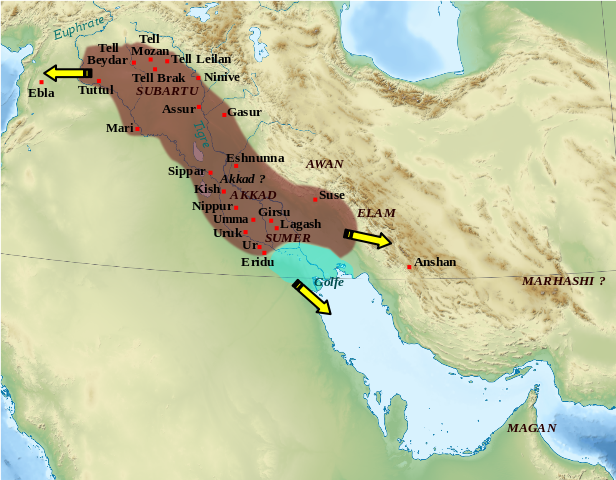

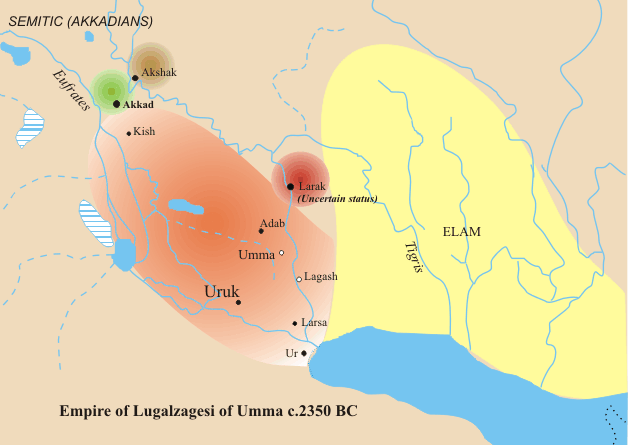
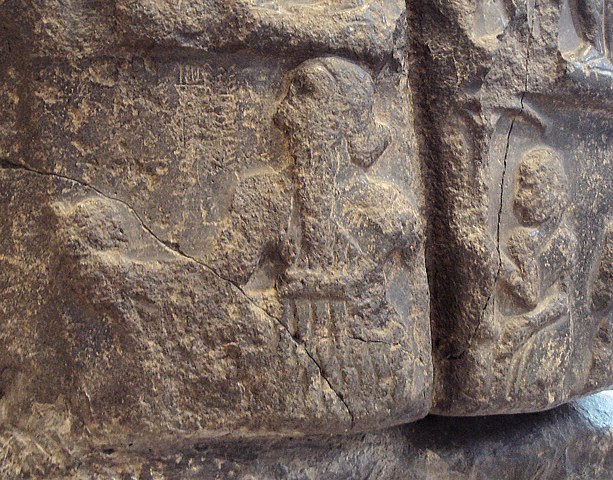
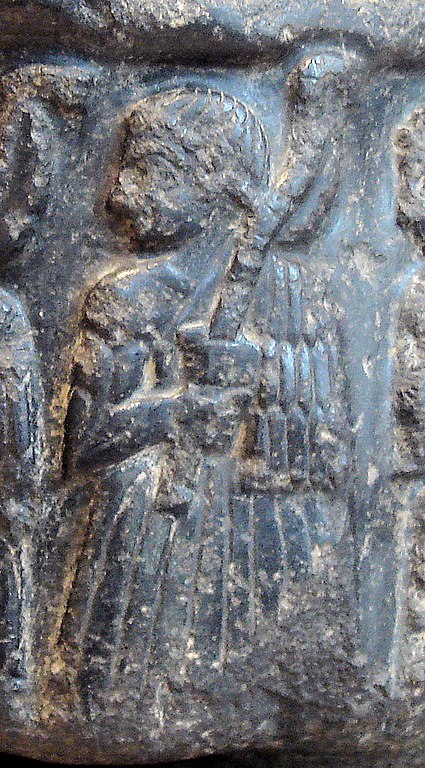
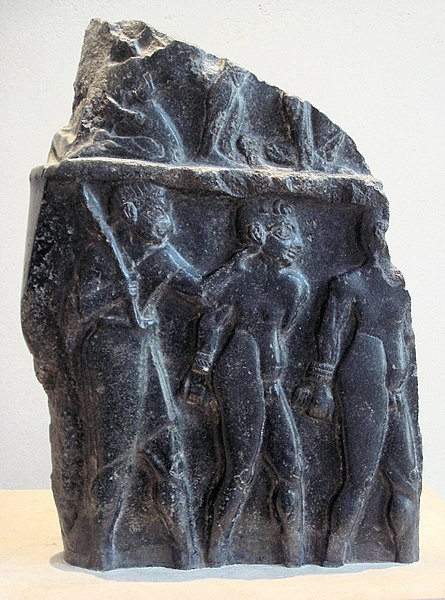
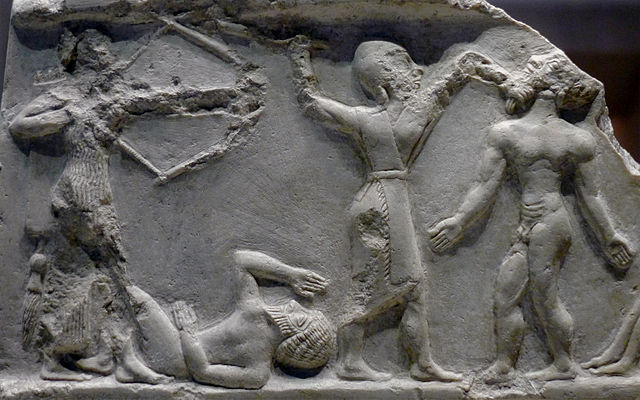
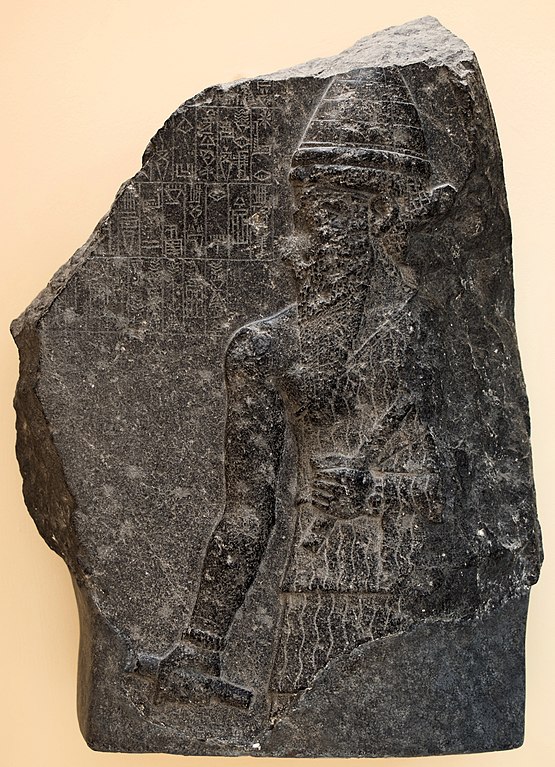
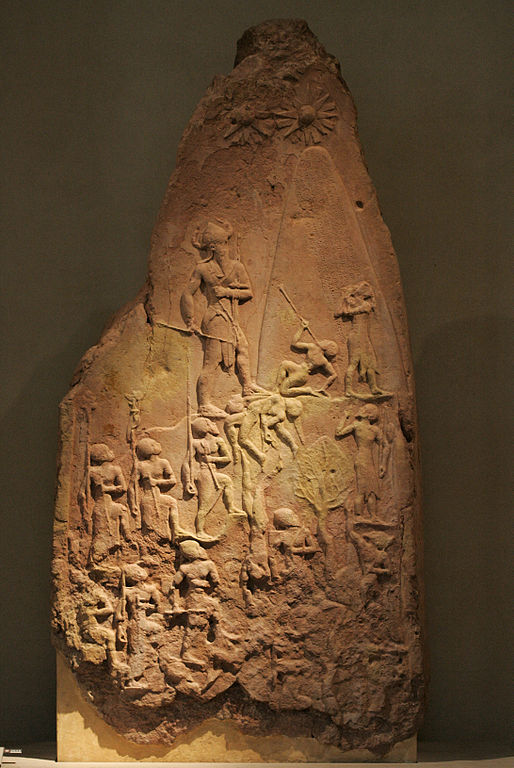
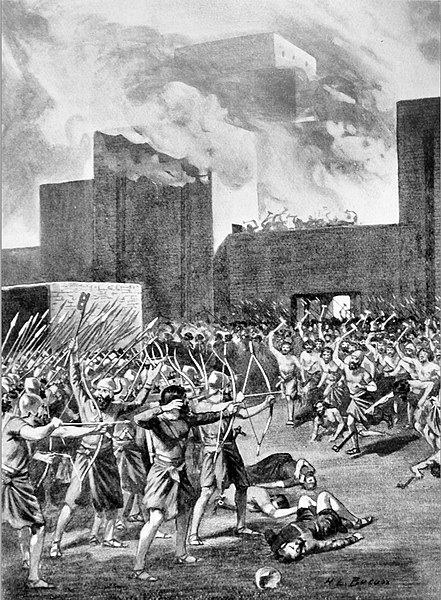
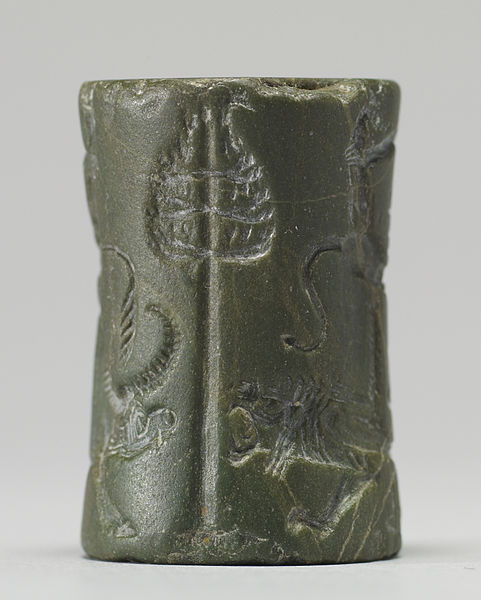

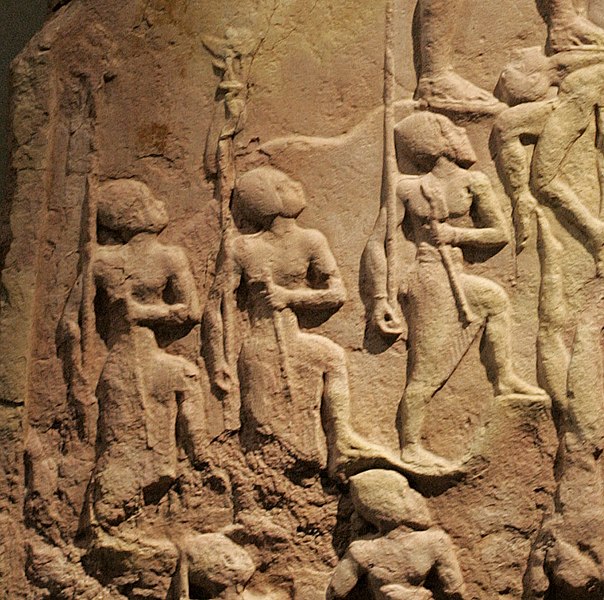
.jpg)
